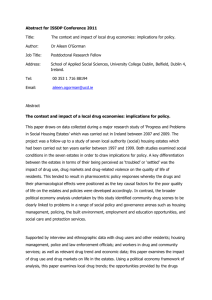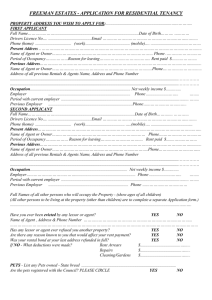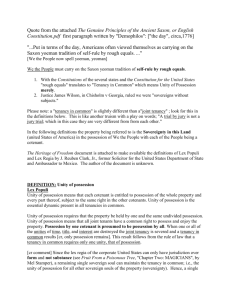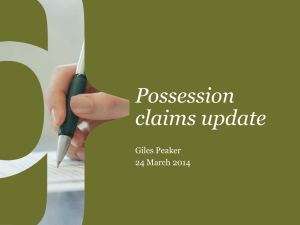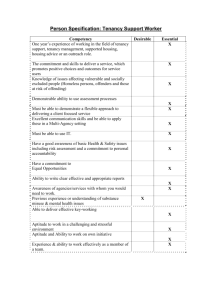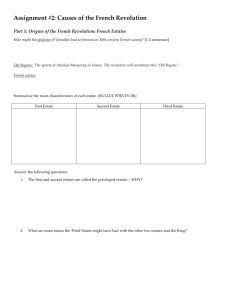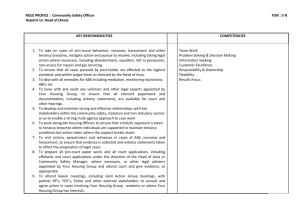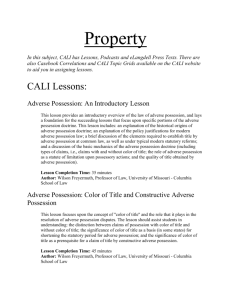Chapter 1 - Practical Step Press
advertisement
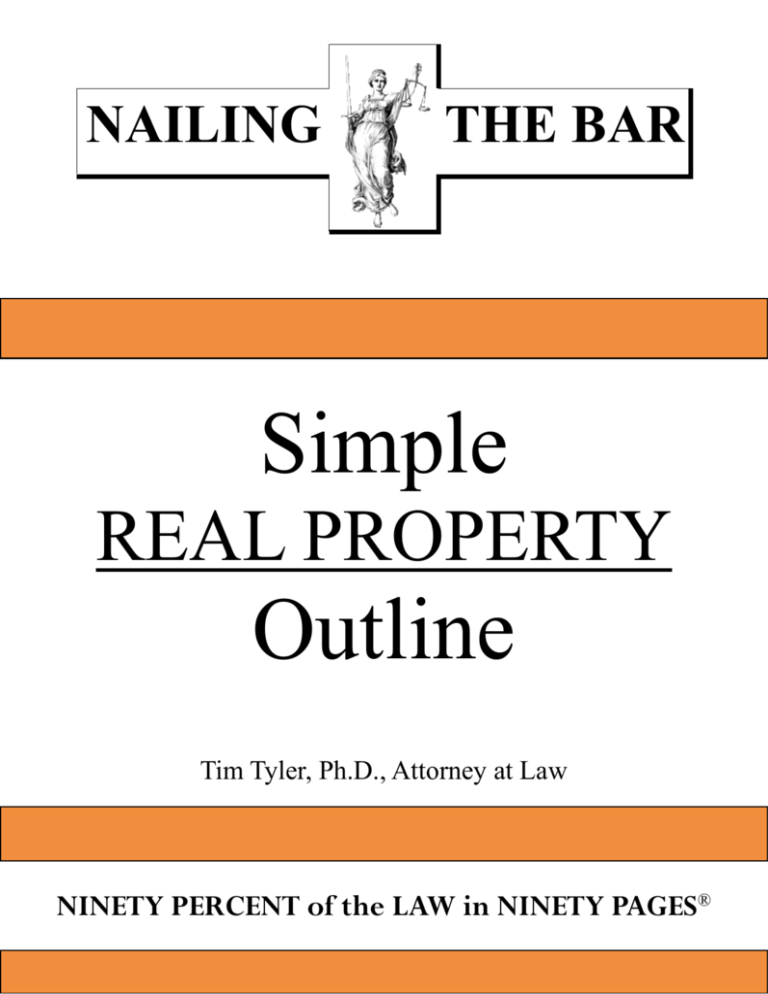
NAILING THE BAR Simple REAL PROPERTY Outline Tim Tyler, Ph.D., Attorney at Law NINETY PERCENT of the LAW in NINETY PAGES® Table of Contents Table of Contents CHAPTER 1: OVERVIEW OF REAL PROPERTY LAW..................................................................... 1 1. THERE ARE ONLY TWO TYPES OF PROPERTY ......................................................................................... 1 2. SEVEN REAL PROPERTY INTERESTS ........................................................................................................ 1 3. TWO TYPES OF ESTATES ......................................................................................................................... 2 4. RESTRAINTS ON ALIENATION ARE GENERALLY DISFAVORED ................................................................ 2 5 DIFFERENT INTERESTS IN LAND ARE CONVEYED IN DIFFERENT WAYS ................................................... 2 CHAPTER 2: FREEHOLD ESTATES ...................................................................................................... 3 1. CURRENT FREEHOLD ESTATES ............................................................................................................... 3 A. Fee Simple Estates............................................................................................................................ 3 1) Fee Simple Modernly Presumed ................................................................................................................... 3 2) Alienability and Passage of Title to Heirs..................................................................................................... 4 3) Fee Simple Absolute is the Largest Estate .................................................................................................... 4 B. Life Estates ....................................................................................................................................... 4 1) The Life Tenant, Measuring Life, and Remaindermen ................................................................................. 4 2) Life Estates Create Reversions and Remainders........................................................................................... 4 3) Life Estates Generally Alienable for Measuring Life ................................................................................... 5 4) Duties of Life Tenants to Remaindermen ..................................................................................................... 5 5) Waste Means Unreasonable Property Changes............................................................................................. 5 C. Fee Tail Estates................................................................................................................................ 6 D. Types of Defeasible Estates and Doctrine of Equitable Waste ........................................................ 6 2. CONDITIONS PRECEDENT AND SUBSEQUENT .......................................................................................... 7 A. Conditions Subsequent ..................................................................................................................... 7 B. Conditions Precedent ....................................................................................................................... 7 C. Conditions Precedent Automatically Terminate Estates .................................................................. 8 D. Failure of a Condition Subsequent Requires Prompt Action ........................................................... 8 3. FUTURE FREEHOLD ESTATES .................................................................................................................. 9 A. Eight Possible Future Estates........................................................................................................... 9 B. Reversions ........................................................................................................................................ 9 C. Indefeasible Remainders .................................................................................................................. 9 D. Vested Remainders Subject to Conditions Subsequent................................................................... 10 E. Vested Remainders Subject to Open ............................................................................................... 10 F. Contingent Remainders .................................................................................................................. 11 G. Conditional Remainders versus Continuing Conditions ................................................................ 11 H. Possibility of Reverter .................................................................................................................... 12 I. Right of Entry .................................................................................................................................. 12 J. Executory Interests.......................................................................................................................... 13 4. MISCELLANEOUS COMMON LAW RULES AND TERMS ........................................................................... 13 CHAPTER 3: VESTING OF CLASS GIFTS AND FUTURE ESTATES ............................................ 14 1. GENERAL RULES FOR GIFTS ................................................................................................................. 14 2. CLASS GIFTS AND THE RULE OF CONVENIENCE .................................................................................... 14 3. VESTING OF CLASS GIFTS ..................................................................................................................... 15 4. THE SIMPLE RULE FOR VESTING OF FUTURE ESTATES ......................................................................... 16 A. Future Estates Retained by Grantor are Always Vested ................................................................ 16 B. All Remainders are Vested Except Contingent Remainders ........................................................... 16 C. Contingent Remainders and Executory Interests are Always Unvested......................................... 16 D. Gifts to Future Members of a Class are Unvested ......................................................................... 17 CHAPTER 4: THE RULE AGAINST PERPETUITIES........................................................................ 18 1. THE MEASURING LIFE .......................................................................................................................... 18 2. COMMON SITUATIONS WHEN THE RAP IS VIOLATED........................................................................... 19 A. Gifts Conditioned to Over 21 Years Almost Always Violate the RAP............................................. 19 v Nailing the Bar – Simple REAL PROPERTY Outline B. Uncertain Conditions Without Time Limit Usually Violate RAP ................................................... 19 C. Future Gifts to “Third Generation” Children Often Violate the RAP ........................................... 20 D. Future Gifts to “Widows” Often Violate the Rap .......................................................................... 20 3. CLASS GIFTS VOID TO ALL IF GIFT IS VOID AS TO ANY MEMBER ........................................................ 20 CHAPTER 5: CONCURRENT ESTATES AND MARITAL PROPERTY ......................................... 21 1. THE THREE FORMS OF CONCURRENT OWNERSHIP................................................................................ 21 A. The Four Unities............................................................................................................................ 21 B. Each Co-Tenant has the Right to Free Use of All of the Land ...................................................... 21 C. The Right of Survivorship.............................................................................................................. 22 D. The Abandoned Use of the Straw Man.......................................................................................... 22 E. All Concurrent Estates can be Partitioned .................................................................................... 23 F. Tenancy by the Entireties .............................................................................................................. 23 1) Tenancy by Entireties Still Presumed in Many States................................................................................. 23 2) No Termination Without Consent............................................................................................................... 23 3) Modernly Conveyance by One Spouse Generally Prohibited ..................................................................... 24 4) Joint Partial Conveyance to Tenant-in-Common ........................................................................................ 24 5) Attachment by Creditors of One Spouse Generally Prohibited................................................................... 24 G. Tenancy-in-Common ..................................................................................................................... 24 1) Modern Presumption Opposite of Common Law ....................................................................................... 25 2) Exception: Interests Held by Fiduciaries .................................................................................................... 25 3) No Right of Survivorship and Shares Freely Alienable .............................................................................. 25 H. Joint Tenancy ................................................................................................................................ 25 1) Joint Tenancy Not Presumed Modernly...................................................................................................... 26 2) Freely Alienable Creating a Tenancy-in-Common ..................................................................................... 26 3) Modernly Conveyance to Self Allowed...................................................................................................... 27 4) States Split on Effect of Mortgage on Joint Tenancy.................................................................................. 27 5) States Split on Effect of Death on Mortgages in Lien Theory States .......................................................... 27 6) States Split on Effect of Leases on Joint Tenancy ...................................................................................... 27 7) Other Acts May Terminate Right of Survivorship...................................................................................... 28 2. THE RIGHTS AND DUTIES OF CO-TENANTS ........................................................................................... 28 A. Fiduciary Duties Between Co-Tenants.......................................................................................... 28 B. Right of Reimbursement for Ouster ............................................................................................... 28 C. Right to Rents and Reimbursement for Depletion ......................................................................... 29 D. No Right to Profits or Benefits Absent Ouster or Depletion ......................................................... 29 E. Right to Reimbursement for Necessary Expenses Only ................................................................. 29 F. No Right to Reimbursement for Improvements.............................................................................. 30 3. DISTRIBUTION OF PROPERTY UPON TERMINATION OF MARRIAGE ........................................................ 30 A. The Minority Community Property Approach ............................................................................... 30 B. The Majority Common Law View .................................................................................................. 30 1) Common Law Rules of Dower and Curtesy Near Abandoned ................................................................... 31 2) Modernly Elective Shares Protect Surviving Spouse.................................................................................. 31 3) Equitable Distribution in Divorce ............................................................................................................... 32 4) Abandoned Common Law Rules ................................................................................................................ 32 CHAPTER 6: NON-FREEHOLD ESTATES.......................................................................................... 33 1. THE CREATION AND CHARACTER OF LEASEHOLDS .............................................................................. 33 A. The Tenancy at Will........................................................................................................................ 33 B. The Tenancy for Years.................................................................................................................... 33 C. The Periodic Tenancy..................................................................................................................... 34 1) Proper Notice is Needed to Terminate Periodic Tenancy ........................................................................... 34 2) Most States Allow Tardy Notice to Apply to Next Period.......................................................................... 35 D. The Tenancy at Sufferance ............................................................................................................. 35 1) Notice Needed if Rent Not Paid.................................................................................................................. 35 2) Holdovers Usually Bound to Periodic Tenancy .......................................................................................... 35 3) Negotiating Landlords Waive Right to Bind............................................................................................... 36 2. THE LANDLORD’S RIGHTS AND DUTIES ................................................................................................ 36 A. The Implied Warranty of Quiet Enjoyment..................................................................................... 36 1) Interference by Paramount Title Claim....................................................................................................... 36 vi Table of Contents 2) Interference by Landlord and Landlord’s Agents ....................................................................................... 37 3) Interference by Tenants and People in Common Areas .............................................................................. 37 4) Tenant’s Remedies for Eviction.................................................................................................................. 38 5) Tenant’s Remedies when Not Evicted ........................................................................................................ 38 B. Implied Warranty of Habitability for Dwellings............................................................................. 38 1) Not When Catastrophic Events Beyond Landlord’s Control ...................................................................... 39 2) Courts Split When Defects Exist at Beginning of Lease............................................................................. 39 3) Remedies of Tenants When Dwellings Uninhabitable................................................................................ 39 C. Landlord’s Duty of Due Care Based on Premises Liability Theory............................................... 41 D. Landlord Duties Based on Privity of Contract............................................................................... 41 1) Lease Agreements for Known Illegal Purposes are Void............................................................................ 41 2) Leases Subsequently Illegal Not Generally Voided.................................................................................... 42 3) Leases Generally Not Voided by Frustration of Purpose ............................................................................ 42 4) Contractual Duties Are Not Escaped by Property Sale ............................................................................... 42 5) New Landlords Takes Possession Subject to Lease .................................................................................... 42 E. Landlord’s Remedies ...................................................................................................................... 43 1) Eviction....................................................................................................................................................... 43 2) Exception: No Retaliatory Eviction ............................................................................................................ 43 3) Exception: Eviction From Low-Income Housing ....................................................................................... 43 4) Self-Help and Forcible Eviction Usually Illegal ......................................................................................... 44 5) Surrender and Abandonment by Tenant ..................................................................................................... 44 3. THE TENANT’S RIGHTS AND DUTIES .................................................................................................... 45 A. Tenant’s Duty to Pay Rent.............................................................................................................. 45 B. Tenant’s Duty to Repair and Avoid Waste...................................................................................... 46 C. Tenant’s Duty to Use Property Reasonably ................................................................................... 46 D. Tenant’s Rights and Duties Regarding Fixtures ............................................................................ 46 4. SUBLETTING AND ASSIGNMENT OF LEASES .......................................................................................... 47 A. Subleases ........................................................................................................................................ 47 B. Lease Assignments.......................................................................................................................... 48 C. Only Express Provision Can Prevent Assignment or Sublease ...................................................... 48 D. Lease Provisions Requiring Landlord’s Consent to Assignment ................................................... 49 5. EMINENT DOMAIN AND CONDEMNATION OF LEASED LAND ................................................................. 49 A. Compensation for Total Condemnation.......................................................................................... 49 B. Compensation for Partial Taking of Land...................................................................................... 50 1) Common Law View: No Termination or Rent Abatement ......................................................................... 50 2) Alternative View: Termination or Rent Abatement .................................................................................... 51 C. Use of Eminent Domain to Facilitate Private Development .......................................................... 52 6. RENT CONTROL .................................................................................................................................... 52 7. ABANDONED COMMON LAW CONCEPTS............................................................................................... 52 CHAPTER 7: DEEDS AND LAND SALES ............................................................................................ 53 1. METHODS OF LAND DESCRIPTION ........................................................................................................ 53 A. Metes and Bounds Method ............................................................................................................ 53 B. Government Survey Method ........................................................................................................... 53 C. Plat or Map Method ....................................................................................................................... 53 D. Incorporation of Other Land Descriptions by Reference............................................................... 54 E. Land Boundaries Described by Streams......................................................................................... 54 F. Rules for Resolving Land Description Errors ................................................................................ 54 2. APPLICATION OF THE STATUTE OF FRAUDS .......................................................................................... 55 A. Statute of Frauds Requirements for Land Sale Contracts .............................................................. 55 1) Written Memorandum May or May Not Prove Oral Contract .................................................................... 55 2) Part Performance Doctrine May Allow Enforcement in Equity.................................................................. 55 3) Written Modification and Rescission Usually Required ............................................................................. 56 B. Equal Dignity Rule for Contractor with Real Estate Broker .......................................................... 56 C. Statute of Frauds Requirements for Real Estate Leases................................................................. 56 1) Writing Needed If Option to Renew Beyond Year ..................................................................................... 57 2) Void Lease Creates Periodic Tenancy ........................................................................................................ 57 3. LAND SALE CONTRACTS ....................................................................................................................... 57 A. Installment Sales Contracts ............................................................................................................ 57 vii Nailing the Bar – Simple REAL PROPERTY Outline B. Options to Purchase Land .............................................................................................................. 58 C. Lump Sum Land Sales Contracts.................................................................................................... 58 D. Effect of Failure to Perform by Settlement Date............................................................................ 59 E. Failure to Deliver Marketable Title Generally Major Breach ....................................................... 60 1) Reasonable Businessperson Standard ......................................................................................................... 60 2) Failure to Deliver Title Free of Defects is Major Breach............................................................................ 60 3) Failure to Deliver Title to all Land Promised is Major Breach ................................................................... 60 4) No Marketable Title Promised with Quitclaim Deed.................................................................................. 61 5) Other Failures to Deliver as Promised Generally Minor Breaches ............................................................. 61 F. Doctrine of Equitable Conversion .................................................................................................. 61 1) Distribution When Seller Dies Intestate...................................................................................................... 61 2) Distribution When Seller Dies Testate........................................................................................................ 62 3) Distribution When Property is Destroyed ................................................................................................... 62 4) Distribution of Insurance When Property Destroyed .................................................................................. 62 G. Assignment of Land Sales Contracts.............................................................................................. 63 H. Broker’s Right to Commission When Sale Fails ............................................................................ 63 I. Requirements for Breach of Land Sales Contracts.......................................................................... 63 J. Remedies for Breach ....................................................................................................................... 63 1) Damages When Sale Fails .......................................................................................................................... 64 2) Damages When Property Sold with Hidden Title Defects .......................................................................... 64 3) Specific Performance.................................................................................................................................. 64 4. PROTECTIONS FOR BONE FIDE PURCHASERS FOR VALUE ..................................................................... 65 5. DELIVERY OF THE DEED ....................................................................................................................... 65 A. Intent to Convey Implied by Deed Delivery.................................................................................... 65 B. When NO Intent to Convey is Presumed......................................................................................... 66 C. Events Causing Title to Irrevocably Pass....................................................................................... 67 1) Title Conveyance by Token Chose ............................................................................................................. 67 2) The Relation Back Doctrine........................................................................................................................ 67 3) Bone Fide Purchaser Gets Title if Grantor Delivers ................................................................................... 68 4) States Split if BFPVW Gets Title by Escrow Agent Error.......................................................................... 68 D. Acceptance of Deed Generally Presumed ...................................................................................... 68 E. Deed Discharges Contract Under Common Law Merger Doctrine ............................................... 68 F. Two Basic Deed Types: Warranty and Quitclaim Deeds ............................................................... 69 1) Present Covenants Apply to Sale and Don’t Run........................................................................................ 69 2) Future Covenants Apply to Future and Do Run.......................................................................................... 70 3) Money Damages Limited............................................................................................................................ 70 G. Special Warranty Deeds................................................................................................................. 70 H. Grantee Taking with Knowledge Does Not Waive Express Covenants.......................................... 70 I. Estoppel by Deed ............................................................................................................................. 71 J. Modernly Home Builders Subject to Implied Warranty .................................................................. 71 K. Seller’s Duty to Disclose Known Concealed Defects ..................................................................... 71 L. Formalities of Seal, Attestation and Acknowledgment ................................................................... 72 6. SALES OF CONDOMINIUMS AND COOPERATIVES ................................................................................... 72 CHAPTER 8: MORTGAGES AND FORECLOSURE .......................................................................... 73 1. MORTGAGE AS DEED SUBJECT TO CONDITION SUBSEQUENT ............................................................... 73 2. PRIORITY OF MORTGAGE CLAIMS......................................................................................................... 73 3. FORECLOSURE PROCESS ....................................................................................................................... 73 A. Strict Foreclosure........................................................................................................................... 74 B. Foreclosure Sales ........................................................................................................................... 74 C. Doctrine of Equity of Redemption .................................................................................................. 74 D. Priority of Claims in Foreclosure .................................................................................................. 74 4. SALE OF MORTGAGED LAND ................................................................................................................ 74 A. New Mortgage or Novation of Old Mortgage ................................................................................ 75 B. Assumption of Mortgage................................................................................................................. 75 C. Taking Property “Subject to Mortgage”........................................................................................ 75 5. ASSIGNMENT OF MORTGAGES BY MORTGAGEE.................................................................................... 76 viii Table of Contents CHAPTER 9: RECORDING STATUTES AND TITLE SEARCH ...................................................... 77 1. THE COMMON LAW PRIORITY OF CLAIM RULES................................................................................... 77 2. RACE RECORDING STATUTES ............................................................................................................... 78 3. NOTICE RECORDING STATUTES ............................................................................................................ 78 4. RACE-NOTICE STATUTES ...................................................................................................................... 78 5. BFPVW MUST BUY FOR ADEQUATE CONSIDERATION......................................................................... 79 6. SITUATIONS WITH CIRCULAR PRIORITIES ............................................................................................. 79 7. OTHER TITLE DEFECTS MAY ALWAYS BE CHALLENGED...................................................................... 79 8. RECORDING OF OTHER INTERESTS ........................................................................................................ 79 9. THE GRANTOR-GRANTEE INDEX AND TITLE SEARCH ........................................................................... 80 CHAPTER 10: ADVERSE POSSESSION............................................................................................... 81 1. PUBLIC POLICY REASONS FOR ADVERSE POSSESSION STATUTES ......................................................... 81 2. ELEMENTS OF ADVERSE POSSESSION ................................................................................................... 81 A. Hostile Possession .......................................................................................................................... 82 1) No Hostile Possession Against Easements or Future Interests.................................................................... 82 2) Generally No Hostile Possession by Tenants.............................................................................................. 82 3) Hostile Possession by Co-Tenant Requires Ouster ..................................................................................... 83 4) Purchase of Another’s Land Begins Hostile Possession ............................................................................. 83 5) Possession in Violation of Statute of Frauds is Hostile............................................................................... 83 6) Boundary Disputes and Agreements........................................................................................................... 83 B. Exclusive Possession ...................................................................................................................... 84 C. Open, Actual, Visible Possession ................................................................................................... 84 D. Continuous, Uninterrupted Possession .......................................................................................... 84 1) Interruption of Possession Terminates Running of Statute ......................................................................... 84 2) Ouster by Third Party Terminates Unless Land Retaken............................................................................ 85 3. LENGTH OF POSSESSION ....................................................................................................................... 85 A. Owner’s Disability May Extend Statute of Limitations Period....................................................... 85 B. Tacking Aggregates Sequential Adverse Possessors ...................................................................... 86 4. EFFECT OF ADVERSE POSSESSION ON OTHER INTERESTS IN THE LAND ................................................ 86 5. RIGHTS AND LIABILITIES CREATED BY ADVERSE POSSESSION ............................................................. 86 6. ADVERSE POSSESSION CLAIMS NOT RECORDED OR SUBJECT TO TITLE SEARCH .................................. 87 CHAPTER 11: EASEMENTS................................................................................................................... 88 1. EASEMENTS APPURTENANT, IN GROSS AND PROFITS ........................................................................... 88 2. FIVE WAYS EASEMENTS ARE CREATED ................................................................................................ 89 A. Easements by Reservation .............................................................................................................. 89 B. Easements by Implication............................................................................................................... 89 C. Prescriptive Easements .................................................................................................................. 90 D. Easements by Express Grant.......................................................................................................... 90 E. Easements by Necessity .................................................................................................................. 90 3. LOCATION AND USE OF EASEMENT ...................................................................................................... 91 4. HOW EASEMENTS TERMINATE.............................................................................................................. 91 A. Termination by Estoppel................................................................................................................. 92 B. Termination Based on Necessity or Lack of Necessity ................................................................... 92 C. Termination by Abandonment But Not Lack of Use ....................................................................... 92 D. Termination by Prescription .......................................................................................................... 93 E. Miscellaneous Situations Causing Easement Termination............................................................. 93 F. Invalid Easement Becomes License ................................................................................................ 93 CHAPTER 12: RESTRICTIVE COVENANTS AND SERVITUDES .................................................. 94 1. REQUIREMENTS FOR A COVENANT TO RUN WITH LAND ...................................................................... 95 2. COVENANTS MUST TOUCH AND CONCERN LAND ................................................................................. 95 A. Non-Competition and Trading Agreements Concern the Land ...................................................... 96 B. Benefit of Covenants Affecting Promisee’s Land Always Run........................................................ 96 C. Burdens of Covenant Do Not Run in Two Situations ..................................................................... 96 ix Nailing the Bar – Simple REAL PROPERTY Outline 3. INTENT FOR COVENANT TO RUN IS MAY BE EXPRESS OR IMPLIED ....................................................... 97 4. TWO TYPES OF PRIVITY REQUIRED FOR COVENANTS TO RUN .............................................................. 97 A. Horizontal Privity Always Required Between Original Parties ..................................................... 97 1) English View: Only Landlord-Tenant Covenants Run ............................................................................... 97 2) Modern American View: Covenants During Land Conveyance Run ......................................................... 98 B. Vertical Privity Needed to all Successors in Interest...................................................................... 98 1) Burdens Run Only if Assignee Gets Entire Estate ...................................................................................... 98 2) Benefits Run if Landholder Gets Any Part of Estate .................................................................................. 99 5. ORIGINAL PROMISOR USUALLY FREE OF LIABILITY FOR COVENANT ................................................... 99 6: REQUIREMENTS FOR EQUITABLE SERVITUDES ..................................................................................... 99 7. EQUITABLE SERVITUDES MUST TOUCH AND CONCERN LAND............................................................ 100 A. Promises That Concern Land Enough for Servitudes to Run ....................................................... 101 B. Equitable Servitude May Not Run if Promisee’s Land Not Benefited .......................................... 101 8. INTENT TO BENEFIT LAND REQUIRED FOR SERVITUDE BENEFIT TO RUN ........................................... 102 9. NO PRIVITY REQUIREMENT FOR EQUITABLE SERVITUDES.................................................................. 102 10. THE BURDEN OF EQUITABLE SERVITUDES RUN TO THOSE WITH NOTICE ........................................ 102 A. Actual Notice. ............................................................................................................................... 103 B. Constructive (Record) Notice ....................................................................................................... 103 C. Inquiry Notice............................................................................................................................... 104 11. IMPLIED RECIPROCAL EQUITABLE SERVITUDES ............................................................................... 104 A. Standing to Enforce Equitable Servitudes .................................................................................... 104 B. Architectural Review Requirements Generally Valid Servitudes ................................................. 105 12. REQUIREMENT OF HOMEOWNER ASSOCIATION APPROVAL OF SALE GENERALLY INVALID ............. 106 13. EVENTS THAT TERMINATE EQUITABLE SERVITUDES........................................................................ 106 CHAPTER 13: ZONING AND LAND USE RESTRICTIONS............................................................ 107 1. PERMANENT PHYSICAL OCCUPATION OR PUBLIC EASEMENT IS A TAKING PER SE .............................. 107 2. CLOSER RELATIONSHIP REQUIRED TO LEGITIMATE PUBLIC NEEDS ................................................... 107 3. USE RESTRICTIONS ARE NOT A TAKING IF LAND RETAINS USEFUL VALUE........................................ 107 4. RESTRICTIONS NEEDED TO PROTECT PUBLIC ARE NOT A TAKING ...................................................... 108 5. EVEN TEMPORARY TAKING DESERVES COMPENSATION .................................................................... 108 6. LAND USE RESTRICTIONS MAY VIOLATE OTHER CONSTITUTIONAL PROTECTIONS ........................... 108 A. Due Process.................................................................................................................................. 109 B. Equal Protection........................................................................................................................... 109 C. Spot Zoning Constitutionally Invalid............................................................................................ 109 D. Some Variance Process is Required............................................................................................. 110 E. Other Freedom of Expression Issues............................................................................................ 110 CHAPTER 14: INCIDENTAL LAND RIGHTS AND DUTIES.......................................................... 111 1. GROUND WATER ................................................................................................................................ 111 2. SURFACE WATER ................................................................................................................................ 111 A. Common Law Riparian Rights ..................................................................................................... 111 B. Prior Appropriation Approach..................................................................................................... 111 3. AIR AND SUN RIGHTS ......................................................................................................................... 112 4. MISCELLANEOUS TORT BASED RIGHTS AND DUTIES .......................................................................... 112 A. Removal of Lateral Support.......................................................................................................... 112 B. Diversion of Surface Water: Common Enemy Doctrine............................................................... 113 CHAPTER 15: CONCLUSION .............................................................................................................. 114 INDEX ....................................................................................................................................................... 115 x Chapter 1: Overview Chapter 1: Overview of Real Property Law Real property law is less uniform than most other areas of law. States are more often split on issues, and often are split several different ways! It is often not clear what the “majority” and “minority” views are on some issues. And the history of real property law involves many arcane terms. Knowing a little about them is of some value. But law schools and bar exams usually test your knowledge of what the common law and broadly adopted modern rules are NOW and not ancient history that has been abandoned. And MBE (Multi-State Bar Exam) answers that cite arcane terms are almost always wrong answers. So, the main focus here is current real property law, and not the historical development. 1. There are Only Two Types of Property There are two types of “property.” Real property is the surface of the earth and everything attached to it, and every other type of property is personal property. The term “property” means something can be “owned” so that the “owner” can prevent others from possessing, using or enjoying it. That is what gives property value.1 Property can also be either tangible (physical things) or intangible (rights), but that distinction has little importance in the case of real property where the value of the land (the thing) springs only from the right (the intangible aspect) to occupy and use the land, now or in the future. 2. Seven Real Property Interests An “interest” is a legally enforceable right. Desires that are unenforceable at law or equity are not interests but only “expectations” that convey no legal rights. There are seven distinct interests in land relevant to the study of real property: 1. ESTATES: The right to OCCUPY land (including life estates, remainders, possibility of reverter, right of entry and executory interests). 2. EASEMENTS: The right to CONTROL land for a LIMITED PURPOSE. 3. COVENANTS: LEGAL RIGHTS arising from land ownership. 4. SERVITUDES: EQUITABLE RIGHTS arising from land ownership. 5. SECURITY INTERESTS: A pledge of land as SECURITY for a DEBT. 6. OPTIONS: An intangible RIGHT TO BUY land. 7. WATER RIGHTS: The right to USE WATER on or adjacent to land. 1 For example, air is valuable but is not property because one cannot feasibly stop others from using it. 1 Nailing the Bar – Simple REAL PROPERTY Outline Chapter 4: The Rule Against Perpetuities The Rule Against Perpetuities (hereinafter “RAP”) is important to three areas of law, wills, trusts and real property. For real property law it voids any future estate that might not vest until far in the future. Modernly it has been modified, but it is still a very important concept to understand. The common law Rule Against Perpetuities is “No interest is good unless it must vest, if at all, within twenty-one years of a life in being at its creation.” To cover the possibility of a child being conceived but not born at the creation of an interest, the 21 year period of the RAP was extended by common law for an additional gestation period (e.g. nine months.) The time period for the RAP is measured by the life of a person who was clearly alive at the time the future estate was created, and they are called a measuring life. The RAP effectively means every future estate is void from the beginning unless it necessarily must either fail or vest within 21 years after the death of all the people alive when it was created, and anyone alive at the creation of an interest could immediately die. The RAP can only void an unvested future estate so it only has application to 1) contingent remainders, 2) executory interests, and 3) class gifts to future members of open classes. And the RAP can NEVER be violated if the grantee of a future estate is identified by name, because their life becomes the measuring life, and the gift must vest in their lifetime or else fail upon their death. So the RAP can only be violated when the grantee is identified only by a description such as “widow”, “child”, “grandchild”, “niece”, etc. 1. The Measuring Life The measuring life for application of the RAP is a person who must be alive when a future estate is conveyed, and that will generally be: 1. The grantor to an unidentified grantee; 2. Some life tenant after whose death the unidentified grantee can take possession, or 3. A person who necessarily must give birth to the unidentified grantee. 18 Chapter 5: Concurrent Estates and Marital Property Chapter 5: Concurrent Estates and Marital Property Freehold estates are frequently concurrent estates held jointly by two or more people who may be called concurrent owners or co-tenants. This is always the case with marital property held in joint title by a couple during marriage. 1. The Three Forms of Concurrent Ownership Under the common law and broadly adopted modern rules two or more people can have concurrent ownership of property in “joint title” in three forms: tenancy by the entireties, joint tenancy or as tenants-in-common. These are referred to as concurrent estates or “joint title forms.” In some States a married couple can also hold title as community property. But students are generally supposed to use only common law and broadly adopted modern rules to answer “real property” questions on Bar Exams. So when answering “real property” questions, including the MBE (Multi-State Bar Exam) questions concerning real property, students should usually just discuss the three joint title forms explained here. — o0o — A. The Four Unities Two of the three types of concurrent estates, tenancy by the entireties and joint tenancy, can only be created if four criteria are met. These are called the four unities (mnemonic=PITT): 1) Unity of Possession: The joint owners must have undivided interests.10 2) Unity of Interest: The joint owners must have equal interests or shares in the property. 3) Unity of Title: The owners must obtain title by the same instrument (deed or will.) 4) Unity of Time: The interests of the joint owners must vest at the same time. The third joint title form, tenancy-in-common, only has to satisfy one of these requirements – unity of possession – and does not have to satisfy the other three requirements. — o0o — B. Each Co-Tenant has the Right to Free Use of All of the Land Concurrent owners (i.e. co-tenants) may partition the land by agreement. Otherwise they each have an undivided interest and right to freely use all of the land, regardless of their 10 “Undivided” means that the land is not partitioned and each owner has a right to use the entirety of it. 21 Chapter 6: Non-Freehold Estates Chapter 6: Non-Freehold Estates A non-freehold estate is a leasehold, an estate for a period of time granted to a leaseholder or tenant (“lessee”) by the landlord (“lessor”.) Leaseholds are usually granted in exchange for rent. But leaseholds create a landlord-tenant relationship and give tenants rights of exclusive occupation that are protected by eviction statutes. That is what distinguishes them from “licenses” (e.g. rental of a motel room) that only create a temporary “innkeeper-guest” relationship. There are four basic types of leaseholds: 1. A tenancy at will: A tenancy that can be terminated by either party at any time; 2. A tenancy for years: Any leasehold for one set time period (even less than a year); 3. A periodic tenancy: A tenancy for repeated time periods (e.g. “month-tomonth”); and 4. A tenancy at sufferance: A tenancy until the landlord decides to evict or renew. 1. The Creation and Character of Leaseholds The main differences among the various types of non-freehold estates (leaseholds) are the notice requirements for terminating or renewing the leasehold for another period of time. — o0o — A. The Tenancy at Will A lease that can, by its terms, be terminated at any time by both parties is a tenancy at will. Some courts hold that any lease that can be terminated by even one party at will is a tenancy at will. But some courts hold that tenancies at will must be for an indefinite period of time. There is no notice requirement for terminating a tenancy at will, and they terminate automatically if the lease is assigned or either party dies. Most courts hold that subleases do not terminate tenancies at will. Assignment and subleasing will be explained below. — o0o — B. The Tenancy for Years A tenancy for years or estate for years, despite its name, is a lease for any fixed or computable period of time, whether more or less than a year. It does not matter if the 33 Chapter 10: Adverse Possession Chapter 10: Adverse Possession The law of adverse possession is statutory so it varies from one State to the other. Adverse possession means that a person may gain legal title to land by occupying it long enough statutes of limitation bar the owners of record from bringing an ejectment action. The most common application of this is in boundary disputes. Once a person has established a right to land by adverse action they can deed it to anyone else with impunity, and valid title will be conveyed. In some cases this starts a new title chain. 1. Public Policy Reasons for Adverse Possession Statutes State laws allow adverse possession for several public policy reasons. The courts don’t want to litigate stale claims, and having statutes of limitation on land claims helps clear land titles and improves property values. It also simplifies title searches by eliminating the need to look at early records. Adverse possession is entirely statutory, and statutes usually exempt government land and utility company land from being taken by adverse possession. Likewise, a spouse cannot seize marital property or the separate property of the other spouse by a claim of ‘adverse possession’. 2. Elements of Adverse Possession A claim of title by adverse possession requires that the claimant take open, actual, visible and exclusive possession of the land in a manner that is hostile to the rights of the “true” owners, and keep it continuously that way for the length of time required by statute. The elements of this rule can be remembered by the mnemonic HELUVA: 1. Hostile Possession: Holding the land in opposition to or defiance of the rights of the owner of record; 2. Exclusive Possession: Holding the land alone, not sharing it with the owner of record; 3. Lengthy Possession: Holding the land for the length of time required by statute; 4. Uninterrupted Possession: Continuous possession without interruption; 5. Visible Possession: Holding the land openly, visible for the owner of record to see; and 6. Actual Possession: Holding the land physically and not just claiming possession. — o0o — 81 Nailing the Bar – Simple REAL PROPERTY Outline Chapter 12: Restrictive Covenants and Servitudes Chapter 7 explained three covenants that may “run with the land” when it is conveyed with a “warranty deed”: the covenants of quiet enjoyment, warranty and further assurances. Other restrictive covenants and “equitable” servitudes are possible as well.36 Restrictive covenants and equitable servitudes are both promises by one landowner (the “promisor”) to another landowner (the “promisee”.) Due to historical development and differences between the English and American courts, there is confusion and inconsistency in the recognized differences between covenants and servitudes. English courts held that covenants were enforceable in a court of law while servitudes were only negative promises (i.e. not to do something) that could be enforced in a court of equity. The distinction is now muddled and you must be aware the terminology is often inconsistent in case law. Nevertheless, the better distinction remains that: Covenants are required acts the landholder has a legal duty to DO; and Servitudes are forbidden uses of the land the landholder has an equitable duty to NOT DO. The basic difference between covenants, servitudes and other contract promises is that covenants and servitudes run with the promisor’s land, binding future owners of the same land to the same promise, and the original promisor is usually released from all further liability.37 This is very different from contract law where contract duties must be expressly assumed by a delagatee and the party that delegates the contract duties usually has continuing liability based on privity of contract. Further, the benefits of a covenant or servitude run with the promisee’s land to new owners, and this is different from contract law where contract benefits are only transferred to assignees by express assignment and delivery of notice of the assignment to the promisor. But covenants and servitudes will NEVER burden a bone fide purchaser for value without notice (BFPVW), and they will almost never apply to adverse possessors, either. Below covenants will be explained first followed by equitable servitudes. 36 Covenants and restrictive servitudes (along with zoning codes) are often are referred modernly to as being the “Codes, Covenants and Restrictions” or “CC&Rs” that control land use. 37 The original promisor who sells is generally released from all further liability because privity of estate is terminated and courts often ignore liability based on privity of contract. This is inconsistent with the usual approach when landlords sell property subject to an ongoing lease or when tenants assign a lease. 94 Index Index Dominant Estates, 88, 89, 90, 91 Dower, 31 1 th 14 Amendment, 49, 107, 108 1st Amendment, 108 E Easements, 2, 55, 60, 63, 69, 77, 80, 82, 84, 86, 88, 89, 90, 91, 92, 93, 98, 107, 112 Easements in Gross, 88, 93 Eminent Domain, 49, 52 Equal Dignity Rule, 56 Equitable Conversion, 62 Equitable Servitude, 88, 94, 97, 99, 100, 101, 102, 103, 104, 105, 106 Equity, 1, 13, 14, 54, 55, 74, 94, 99 Estates, 1, 2, 3, 4, 5, 6, 7, 8, 9, 10, 11, 13, 14, 16, 19, 20, 21, 23, 26, 28, 30, 33, 37, 46, 82, 86, 88, 89, 91, 92, 96 Estates Subject to Conditions, 6 Estoppel, 14, 55, 71, 77, 91, 92 Estoppel by Deed, 71 Executory Interest, 1, 6, 13, 16, 17, 18 Express conditions, 4, 6, 48 5 th 5 Amendment, 108 A Accretion, 54 Adverse possession, 2, 60, 80, 81, 82, 83, 84, 85, 86, 87, 90, 92 Affirmative waste, 5 Alimony, 32 Ameliorative waste, 5 Appurtenant, easements, 2, 88, 90, 91, 93, 111 Assignment of leases, 33, 47, 48, 49, 63, 76, 94 Avulsion, 54 B F Bone Fide Purchaser for Value, 3, 58, 65, 67, 68, 77, 82, 94, 96, 102 Failure of Conditions, 13 Fee Simple, 3, 4, 6, 9, 13, 17, 26, 31, 55, 65, 98 Fee Tail, 3, 6, 31 Fixtures, 46, 47 Foreclosure, 28, 57, 73, 74, 96 Four Unities, 21, 22, 23, 24, 25, 26 Fraud, 42, 79, 96 Freehold Estates, 3, 9, 21, 33, 65, 69, 96, 98, 99 Future Estates, 2, 3, 4, 7, 8, 9, 10, 11, 12, 13, 14, 16, 17, 18, 19, 20, 37, 46, 86 C Class Gifts, 14, 17, 18, 20 Common law Merger Doctrine, 68, 72 Community Property, 30, 114, 118, 119 Concealed defects, 39 Concurrent Estates, 21, 23 Condemnation, 49, 106 Condition Precedent, 6, 8, 9, 10, 11, 12, 13, 16 Condition Subsequent, 6, 7, 8, 10, 12, 13, 17, 73 Condominiums, 52, 72, 106 Contingent Remainders, 10, 11, 13, 16, 18 Continuing Conditions, 11 Covenant of Further Assurances, 69, 70 Covenant of Quiet Enjoyment, 38, 69, 70, 99 Covenant of Right to Convey, 69 Covenant of Seisin, 69 Covenant of Warranty, 70 Covenants Running with the Land, 42, 96, 98, 99 Coverture, 32 Curtesy, 31 G Grant Deed, 60 Grantor-Grantee Index, 80 H Habitability, implied covenant of, 36, 38, 39, 43, 46, 71 Holdover Tenants, 34, 35, 36, 43, 82, 83 Homeowner Associations, 106 Horizontal Privity, 97, 98 Hostile Possession, 82, 83, 84, 85, 86, 87 D I Damages, 5, 6, 28, 38, 40, 43, 47, 48, 49, 50, 51, 54, 58, 59, 61, 63, 64, 68, 70, 86, 95, 100 Defeasible, 6, 7, 9, 11, 15, 37, 46, 66 Destructibility of Contingent Remainders, 13 Detrimental Reliance, 55, 77, 92 Doctrine of Equitable Conversion, 61, 62 Doctrine of Equitable Waste, 7 Implied Covenant of Habitability, 36, 38, 39, 43, 46, 71 Implied Covenants, 38, 99 Implied Reciprocal Servitudes, 104, 105 Independent Covenants, 52 Installment Sales, 57, 73 115 Nailing the Bar – Simple REAL PROPERTY Outline Interests in Land, 2, 58, 73, 78 Q Quiet enjoyment, implied covenant of, 36, 37, 38, 43, 45, 69, 70, 94, 99 Quitclaim Deeds, 58, 60, 61, 65, 69, 70, 96 J Joint Tenancy, 21, 22, 23, 25, 26, 27, 28, 73 Jure Uxoris, 32 R K Real Property, 1, 2, 13, 18, 21, 30, 31, 32, 41, 42, 46, 52, 56, 71, 119 Rebuttable presumption, 23, 65, 66 Recording statutes, 77, 78, 79, 103 Reimbursement, 28, 29, 30, 40 Relation Back Doctrine, 67, 68 Reliction, 54 Remainder, 4, 6, 9, 10, 11, 12, 16, 20, 26, 83, 99 Remaindermen, 4, 5, 6, 9, 46 Remainders Subject to Open, 10 Remedies, 29, 37, 38, 39, 43, 45, 63, 118, 119 Rent Control, 52 Reversion, 4, 9, 99 Reversions, 4, 9, 13, 16 Reverter, possibility of, 1, 11, 12, 16, 60 Right of Entry, 1, 10, 12 Right of Survivorship, 22, 23, 24, 25, 26, 27, 28, 32 Riparian, 111, 112 Rule Against Perpetuities, 10, 11, 13, 14, 15, 18 Rule of Convenience, 14, 15 Running with the land, 2, 42, 69, 70, 91, 94, 95, 96, 97, 98, 99, 100, 101, 102, 103, 105 Known Trespassers, 112 L Lateral Support, 88, 112 Lease Assignments, 48 Lien Theory States, 27, 73 Life Estates, 1, 4, 5, 13, 26, 37 Life Tenants, 4, 5, 6, 7, 9, 18, 46 Livery of Seisin, 13 Lump Sum Land Sales, 57, 58 M Major Breach, 59, 60, 61 Marital Property, 21, 23, 30, 32, 81 Marketable Title, 58, 60, 61, 64, 87 Measuring Life, 4, 5, 18, 19, 20 Merger Doctrine, 13, 68, 72 Metes and Bounds, 53 Mistake, iv, 42 Moore, 109 Mortgages, 5, 27, 29, 58, 59, 60, 69, 72, 73, 74, 75, 76, 79, 104 S Sales Broker Commissions, iv, 63 Security Interests, 27 Seisin, 13, 69 Semantics, 7 Servient Estates, 88, 89, 90, 91, 92, 93 Servitudes running with the land, 60, 88, 94, 97, 99, 100, 101, 102, 103, 104, 105, 106 Settlement Date, 59, 60, 63 Special Warranty Deeds, 70 Specific Performance, 55, 56, 61, 63, 64 Statute of Frauds, 34, 55, 56, 57, 58, 83, 89, 93, 95, 100, 102 Statute of Uses, 13 Strict Liability, 112 Surface Water, 111, 113 Surrender and Acceptance, 5, 44, 45 N Non-Freehold Estates, 3, 33 O Options, 58 Ouster, 28, 29, 83, 85 P Part Performance Doctrine, 55, 56 Partitioning land, 21, 23, 29, 30 Per Autre Vie, Life Estate, 4, 5 Periodic Tenancy, 33, 35, 57, 82 Permissive Waste, 5 Personal Property, 1, 31, 32, 46, 52, 62, 111 Possessory estates, 2, 3, 9, 82 Possibility of Reverter, 1, 11, 12 Premises Liability, 41 Prescription, 2, 89, 92, 93 Prescriptive Easements, 90 Privity of Contract, 42, 47, 94, 99 Privity of Estate, 42, 47, 90, 94, 97, 99 Privity, horizontal, 97, 98 Privity, vertical, 98, 102 T Tacking, 86, 90 Tenancy at Sufferance, 33, 34 Tenancy by the Entireties, 21, 22, 23, 24, 25, 30, 32 Tenancy for Years, 33, 34, 35, 57 Tenants-in-Common, 21, 23, 26, 30, 72 Third Party Beneficiary, 47 Title Defects, 60, 65, 67, 70 Title Search, 59, 71, 80, 81, 87 Title Theory States, 27, 73 Titleholder, 2, 14 116 Index Token Chose, 14, 66, 67 Touch and Concern the Land, 95, 96, 99, 100, 101 Vesting of Class Gifts, 14, 15 Vesting of Future Estates, 16 U W Under Color of Title, 83, 87 Warranty Deeds, 69, 70, 71, 94, 96 Waste, 5, 6, 7, 45, 46 Water Rights, 111 Worthier Title, Doctrine of, 13 V Vertical Privity, 98, 102 Vested, 2, 10, 11, 14, 15, 16, 17, 26 Vested Remainders, 10, 11 Vesting, 14, 15, 16 Z Zoning, 23, 60, 94, 107, 109, 110, 112 117 What LAW STUDENTS say about SIMPLE OUTLINES — Got your “simple outline”… read it in just ONE day the first week of my class. Think I was about the only student who even understood where the professor was going with the class all semester — Michael M. Love the Bevis and Butthead examples! — Kim R. Purchased your outline set :-) -- Great stuff! — Rueben The focus on basic rules really helped me. Reading case law had me all screwed up — Michelle R. Great time-saver! I could review it before exams — Jason D. The outlines are sooo AWESOME. I don't think anyone in my school knows about them — Naisha J. NINETY PERCENT of the LAW in NINETY PAGES® HOW this book is different and WHY TO BUY IT— TIME IS PRECIOUS. This SIMPLE OUTLINE is CONCISE so you can read it QUICKLY and immediately get a GENERAL UNDERSTANDING of the subject matter at the BEGINNING OF YOUR CLASS when it really helps. SIMPLE IS BETTER. As your class progresses, this SIMPLE OUTLINE explains the broadly adopted BLACK LETTER LAW and BRIGHT LINE RULES of law AS THEY NOW EXIST using EXAMPLES. Other resources dwell on case law and historical development that just causes misunderstanding and confusion. EXAMS ARE WHAT COUNTS. This SIMPLE OUTLINE is so COMPACT you can QUICKLY REVIEW IT BEFORE EXAMS. You can’t do that with a hornbook or “commercial outline” that is hundreds of pages long because there SIMPLY ISN’T ENOUGH TIME. ISBN 978-1-936160-28-0 Published by Practical Step Press www.PracticalStepPress.com O-8
